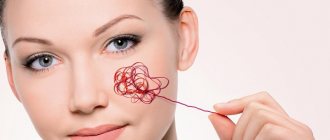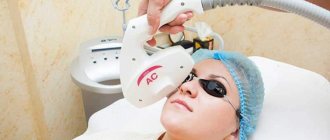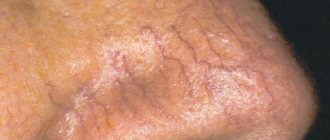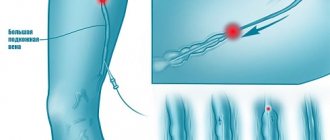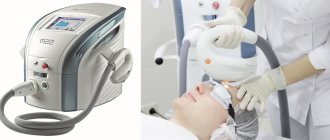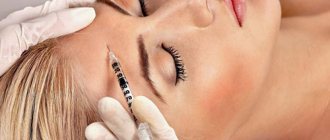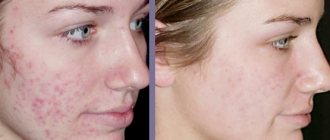What it is
Electrocoagulation is a minimally invasive procedure that involves removing blood vessels and tumors on the skin using temperature. The session is carried out using electric current. As a result of the current coming into contact with the affected area of the skin, the protein is destructured and folded.
The vascular network on the face appears due to the fact that the tone of the vascular walls is weak. Insufficient elasticity of blood vessels leads to their overflow and stretching. As a result of electrocoagulation, the following occurs:
- thermal effects - heating tissues to a high temperature;
- physico-chemical effect - the attraction of cells is destroyed;
- biological – death of affected tissues and regeneration.
Thanks to the effect of the device, the affected vessels are destroyed. The walls of the capillaries come closer together, stick together, and the vessel ceases to participate in the blood supply. After dissolving the damaged areas, the vascular network disappears from the face.
Infrared photocoagulation
This method is considered relatively new, but may well compete with laser removal of blood vessels. Infrared rays help get rid of fairly large vessels. The technology is also used in the treatment of varicose veins. There is equipment for treating rosacea on the face. Under the influence of infrared radiation, blood coagulates. A crust appears on the surface of the affected area, which disappears after a few days.
Dilated blood vessels on the face can be effectively removed using infrared radiation
The advantage of this technique is the rapid removal of damaged vessels. It only takes a few seconds to complete one section. Several dilated vessels can be removed in one procedure. The treatment is practically painless. The patient may only feel a slight tingling sensation during the session.
Advantages
The main advantages of electrocoagulation are efficiency, speed and minimal side effects. This list can be supplemented with the following items:
- ease of execution;
- low cost of a session and inexpensive equipment;
- no preliminary preparation required;
- long lasting results;
- healing speed;
- no bleeding;
- When removing a tumor, part of the tissue can be taken for histological analysis.
Electrocoagulation causes minimal damage to the skin. The master can control the intensity of the impact and the depth of penetration of the current. Due to the fact that healing occurs quickly, there is virtually no risk of infection.
Comparison of electrocoagulation with laser therapy
The use of laser in cosmetology, in contrast to electrocoagulation, allows one to influence pathological tissue with very high precision. There is no damage to surrounding healthy cells and no prolonged pain during the recovery period. The healing process occurs much faster, and the risk of the complications listed above is reduced many times. Using a laser, it is possible to treat rosacea and eliminate age spots.
However, when deciding which is better - electrocoagulation or laser, the following factors should be taken into account:
- The optimal use of laser therapy is mainly the treatment of defects that are at the same level with the skin surface (seborrheic keratosis, hemangiomas, spider veins, pigmented spots, small flat papillomas on a wide base, etc.);
- high cost of laser treatment.
Despite the availability of a more advanced laser method, electrocoagulation in cosmetology remains a universal and popular method due to its effectiveness, safety, ease of use and low cost of equipment and procedures.
Contraindications
Electrocoagulation is a medical technique and has its contraindications.
The procedure cannot be performed if:
- pregnancy;
- diabetes mellitus;
- poor blood clotting;
- acute infectious diseases;
- HIV and AIDS;
- epilepsy;
- diseases of the cardiovascular system.
The procedure is also not recommended for recently tanned skin and for cancer patients.
Electrocoagulation of blood vessels on the face
The appearance of rosacea, which appears on the skin in the form of a red fine mesh, is a problem familiar to many people. This is a serious cosmetic defect that is difficult to disguise with foundation and powder. There may be several reasons for the appearance of rosacea:
- overexertion, for example, during heavy physical work or labor;
- hereditary predisposition, manifested in weakness of the vascular walls;
- hormonal disorders caused by age-related changes;
- traumatic effect on the deep layers of the skin;
- the body's reaction to elevated temperature.
The problem can appear in a variety of areas of the face and body, but most often it “attacks” the wings of the nose, eyelids, nose, cheekbones and décolleté. You can get rid of the vascular network completely painlessly - you just need to make an appointment with us for the removal of blood vessels using photocoagulation.
The BBL device, which is used to remove broken blood vessels in a specialized office, affects the skin with pulsed high-intensity broadband light. This is a completely safe way to get rid of the problem for a long time, even forever. The non-invasive technique starts the process of coagulation (clotting) of damaged areas of the vascular system. The technique has many advantages:
- Safety.
Vascular coagulation is possible at any age and on any part of the face and body. Even removing damaged blood vessels on the eyelids does not have any negative consequences. - Painless.
The procedure is carried out in the most comfortable conditions for the patient; an advanced cooling system adjusts the temperature in the treatment area. Removal of dilated vessels does not even require local anesthesia. - Instant effect
even with minimal exposure, plus a general improvement in the condition of the treated skin area. - The procedure takes
no more than half an hour, which is very convenient for patients with a busy life schedule.
Photoremoval of vessels should be postponed if the patient has the following diseases or conditions:
- During pregnancy and breastfeeding;
- untreated infection;
- atopic dermatitis or psoriasis;
- unhealed wounds, burns and other injuries.
You will have to refuse the procedure if you:
- diabetes mellitus of any type;
- hypertension and endocrine disorders;
- diseases of the organs of vision with organic damage to the retina or lens;
- increased intraocular pressure.
Removal of blood vessels on the face (Moscow) is a procedure that must be coordinated with a specialist. That is why, before prescribing it at our center, you will be offered to undergo an examination and receive professional advice. The number of sessions and their duration will depend on the area of the vascular network that needs to be removed.
Photocoagulation of vessels on the face most often involves the removal of vessels on the nose. Often the appearance of a characteristic pattern on the wings of the nose indicates the presence of a herpes infection in the blood or the adverse effects of low temperatures and ultraviolet radiation on the skin. Such rosacea is accompanied by burning and tingling. And in an advanced stage it can lead to nasal deformation, tissue growth and serious cosmetic problems. Removing the vessels on the wings of the nose in this case is the only way out of the situation.
Photocoagulation of the neck is another common and sought after procedure. It is easy to cope with this problem in one session using BBL if the area of the vascular network is not very extensive. You can also deal with blood vessels in the décolleté area in just one session when using this device.
Removal of blood vessels on the cheekbones and chin is completely painless. In this area, the skin remains elastic and dense for quite a long time, maintaining its structure.
Application technique
No preliminary preparation is required before the procedure. The algorithm of actions in different institutions may vary somewhat, but the general procedure is as follows:
- The procedure is painful, so anesthesia is performed. For this purpose, ointment or cream is applied to the treated area.
- The equipment is configured and the required intensity of exposure is established.
- Starting from the periphery, the skin is processed. Depending on the area of the treated area, the procedure takes from 5 to 30 minutes. Additional sessions may not be necessary.
- Apply 5% potassium permanganate to the remaining crusts.
Rehabilitation after photocoagulation
If the treatment was carried out on a large area of the face, minor side effects may appear immediately after the procedure. This is hyperemia and slight swelling. Therefore, patients who are planning to remove spider veins should take a vacation or sick leave. Unpleasant symptoms usually go away within a week. To reduce negative manifestations, the specialist applies cold lotions to the face immediately after the photocoagulation session. To avoid infection of the affected area, an ointment with an antibacterial effect selected by a doctor is applied to the face.
A common complication after photocoagulation is hyperpigmentation. In this regard, many experts recommend carrying out the procedure in winter. And if it is not possible to prevent exposure to ultraviolet radiation, you need to use a face cream with a high level of protection. It is not recommended to use a sauna or steam bath for several months after removing the vessels, otherwise the dilated vessels will appear again, but in other places.
After removing the vessels, it is necessary to avoid direct sunlight
Crusts often form at sites exposed to laser or infrared radiation. Under no circumstances should you remove them yourself. This may cause scars. The crusts usually fall off on their own a few days after the procedure.
For a month after the removal of blood vessels, it is necessary to protect the face from the effects of negative factors. Don't be nervous or overcool. You will also have to give up increased physical activity.
Side effects
When performing electrocoagulation, the following negative consequences are possible:
- Allergies – the appearance of redness and rashes. Rarely – dermatitis.
- Development of inflammation. As a rule, this happens when the treated area is not properly cared for.
- Bleeding if the doctor violated the execution technology.
When the procedure is carried out by a qualified specialist and when skin care recommendations are followed, no side effects occur.
Important! You should not drink alcohol before the procedure. It slows down the tissue repair process and reduces the effectiveness of the pain reliever.
Features of the event
To get rid of dilated capillaries, you need equipment that generates low-frequency electric current. An impulse is applied to the skin using a handpiece to which an electrode is attached. The procedure on different parts of the body differs in some nuances. It makes sense to use electrocoagulation if the diameter of the problem vessels is at least 0.3 mm.
Electrocoagulation of blood vessels on the face is carried out in stages:
- First, the skin is freed from cosmetics. Then it is wiped with an antiseptic.
- The problem area of the face is treated with lidocaine from above. But if the area of skin that needs changes is small and the patient’s pain threshold is high, you can do without anesthesia.
- The specialist applies current to the vessels using a needle conductor. The electrode is placed into the skin to a depth of 1 mm, without missing any dilated capillaries. With each dive, an impulse is given that “cauterizes” the vessel, making it immediately invisible.
- When the entire area of skin with rosacea has been treated, the face is again wiped with an antiseptic. A soothing corticosteroid ointment is then applied to prevent complications.
In most cases, it is possible to solve the problem in a single session. But if there are a lot of dilated capillaries, you have to do this in several procedures, carried out at intervals of 7 - 10 days.
The fact is that the skin turns red from exposure to electricity, and some of the problem vessels become invisible to the specialist. The work of removing them is quite painstaking, since the capillaries on the face are small. And in order not to keep the patient in a chair for hours, if the affected area is large, it is better to do it in 2 - 3 sessions.
To learn how electrocoagulation of blood vessels is performed, watch this video:
Electrocoagulation of blood vessels in the legs can be performed using the monopolar method. The skin in places where they expand should be disinfected with an antiseptic solution. An inactive electrode is placed under the thigh or shin (this depends on which area there is a problem). It looks like a flat metal plate.
Prevention of spider veins
To prevent the appearance of spider veins, you must adhere to the following recommendations:
- Use only high-quality cosmetics. It is advisable to use organic products. Particular attention should be paid to the expiration date of the product.
- Do not wash your face with soap, because after such exposure the skin lacks oxygen and irritation appears.
- Avoid exposure to high temperatures.
- Wash your face first with warm water and then with cold water.
The essence of the procedure
Coagulation, performed using electric current, is the sealing of problematic vessels.
They become translucent due to insufficient tone of their walls. The defect leads to capillaries overflowing with blood, stretching, and loss of elasticity.
If the vessels have already dilated, then they remain that way. It is impossible to return them to their previous position; care must be taken to ensure that problem areas of the system are excluded from it.
This can be done by electrocoagulation, that is, exposure to electric current. It has the following influence:
- thermal, which causes heating of living tissues to a high temperature and burns;
- dynamic, that is, changing their structure;
- physico-chemical, in which the attraction of cells to each other is destroyed;
- biological, that is, stimulating the death of some tissues and the regeneration of other tissues.
Electrocoagulation apparatus
All this together leads to the evaporation of blood from problematic vessels, bringing their walls closer together and gluing. Pathological segments first cease to participate in the blood supply system and then resolve. Externally, this is manifested by the disappearance of the vascular network appearing on the skin.
Price range
Prices vary depending on the region. Average cost in the Central Black Earth region:
| Workload | Price |
| Removal of vascular network 1 cm2 of skin | From 100 rubles |
| Spider vein removal | From 200 rubles |
| Removal of 3-5 spider veins | From 150 rubles each |
| Removal of more than 5 spider veins | From 90 rubles |

